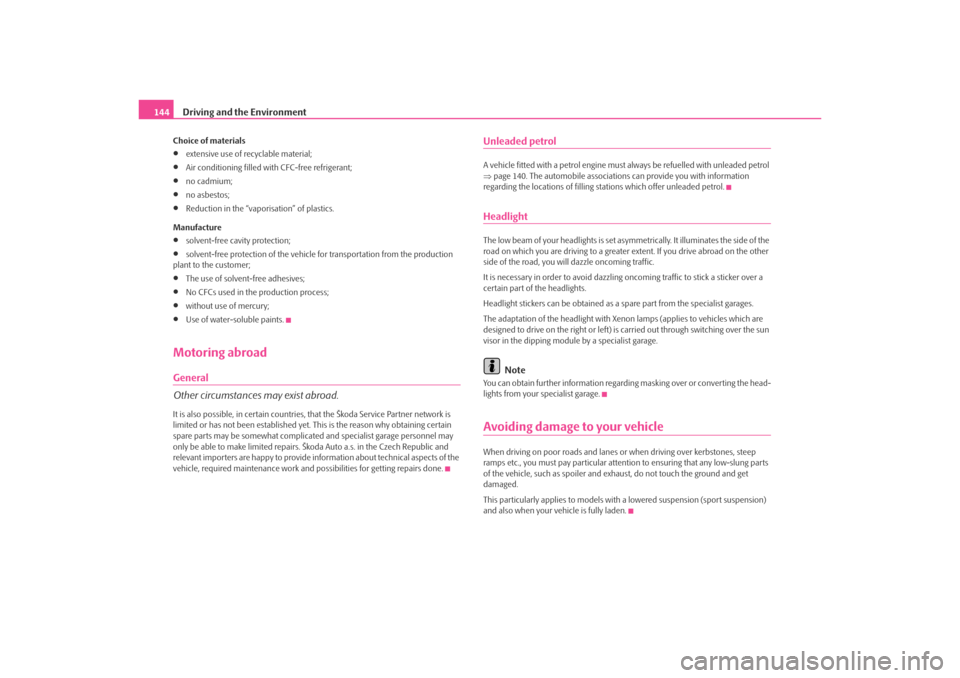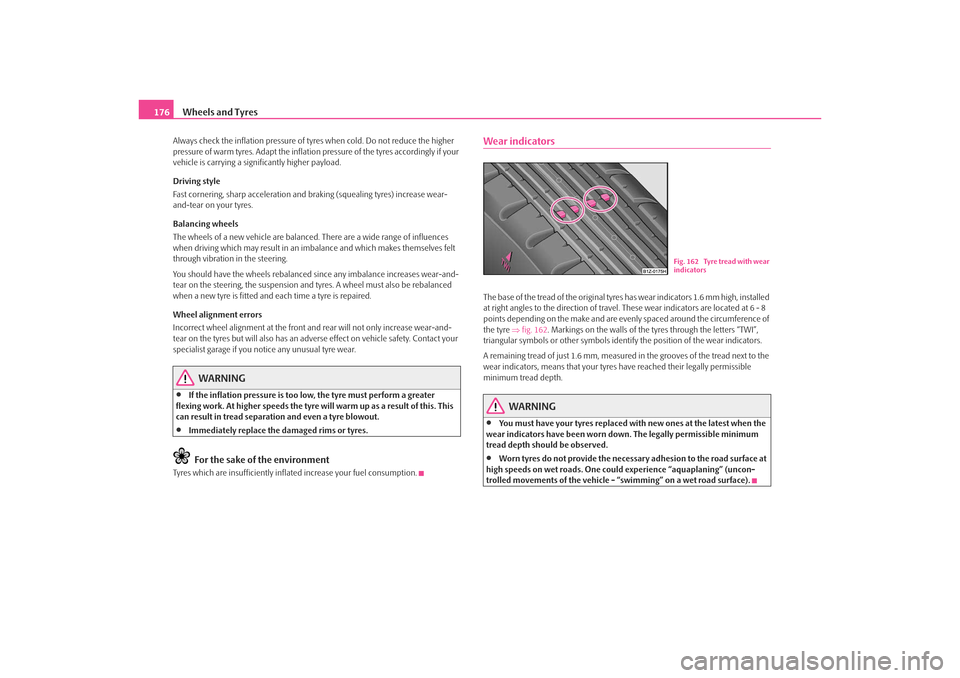air suspension SKODA OCTAVIA TOUR 2009 1.G / (1U) Owner's Manual
[x] Cancel search | Manufacturer: SKODA, Model Year: 2009, Model line: OCTAVIA TOUR, Model: SKODA OCTAVIA TOUR 2009 1.G / (1U)Pages: 226, PDF Size: 13.11 MB
Page 145 of 226

Driving and the Environment
144Choice of materials•
extensive use of recyclable material;
•
Air conditioning filled wi th CFC-free refrigerant;
•
no cadmium;
•
no asbestos;
•
Reduction in the “vaporisation” of plastics.
Manufacture
•
solvent-free cavity protection;
•
solvent-free protection of the vehicle for transportation from the production
plant to the customer;
•
The use of solvent-free adhesives;
•
No CFCs used in the production process;
•
without use of mercury;
•
Use of water-soluble paints.
Motoring abroadGeneral
Other circumstances may exist abroad.It is also possible, in certain countries, that the Škoda Service Partner network is
limited or has not be en established yet. This is th e reason why obtaining certain
spare parts may be somewhat complicate d and specialist garage personnel may
only be able to make limited repairs. Šk oda Auto a.s. in the Czech Republic and
relevant importers are happy to provide information about technical aspects of the
vehicle, required maintenance work and possibilities for getting repairs done.
Unleaded petrolA vehicle fitted with a petrol engine must always be refuelled with unleaded petrol
⇒ page 140. The automobile associations can provide you with information
regarding the locations of filling stations which offer unleaded petrol.HeadlightThe low beam of your headlights is set asym metrically. It illuminates the side of the
road on which you are driving to a greater extent. If you drive abroad on the other
side of the road, you wi ll dazzle oncoming traffic.
It is necessary in order to avoid dazzling oncoming traffic to stick a sticker over a
certain part of the headlights.
Headlight stickers can be obtained as a spare part from the specialist garages.
The adaptation of the headlight with Xe non lamps (applies to vehicles which are
designed to drive on the right or left) is carried out through switching over the sun
visor in the dipping module by a specialist garage.
Note
You can obtain further information regardin g masking over or converting the head-
lights from your specialist garage.Avoiding damage to your vehicleWhen driving on poor roads and lanes or when driving over kerbstones, steep
ramps etc., you must pay particular attent ion to ensuring that any low-slung parts
of the vehicle, such as spoiler and ex haust, do not touch the ground and get
damaged.
This particularly applies to models with a lowered suspension (sport suspension)
and also when your vehicle is fully laden.
s2ig.book Page 144 Monday, November 10, 2008 11:20 AM
Page 177 of 226

Wheels and Tyres
176Always check the inflation pressure of ty res when cold. Do not reduce the higher
pressure of warm tyres. Adapt the inflation pressure of the tyres accordingly if your
vehicle is carrying a significantly higher payload.
Driving style
Fast cornering, sharp acceleration and braking (squealing tyres) increase wear-
and-tear on your tyres.
Balancing wheels
The wheels of a new vehicle are balanced. There are a wide range of influences
when driving which may result in an imbalance and which makes themselves felt
through vibration in the steering.
You should have the wheels rebalanced since any imbalance increases wear-and-
tear on the steering, the suspension and tyres. A wheel must also be rebalanced
when a new tyre is fitted and each time a tyre is repaired.
Wheel alignment errors
Incorrect wheel alignment at the front and rear will not only increase wear-and-
tear on the tyres but will also has an adve rse effect on vehicle safety. Contact your
specialist garage if you notice any unusual tyre wear.
WARNING
•
If the inflation pressure is too low, the tyre must perform a greater
flexing work. At higher speeds the tyre will warm up as a result of this. This
can result in tread separation and even a tyre blowout.
•
Immediately replace the damaged rims or tyres.For the sake of the environment
Tyres which are insufficiently inflated increase your fuel consumption.
Wear indicatorsThe base of the tread of the original tyres has wear indicators 1.6 mm high, installed
at right angles to the direction of travel. These wear indicators are located at 6 - 8
points depending on the make and are evenly spaced around the circumference of
the tyre ⇒fig. 162 . Markings on the walls of the tyres through the letters “TWI”,
triangular symbols or other symbols identi fy the position of the wear indicators.
A remaining tread of just 1.6 mm, measured in the grooves of the tread next to the
wear indicators, means that your tyres have reached their legally permissible
minimum tread depth.
WARNING
•
You must have your tyres replaced with new ones at the latest when the
wear indicators have been worn do wn. The legally permissible minimum
tread depth should be observed.
•
Worn tyres do not provide the necessar y adhesion to the road surface at
high speeds on wet roads. One could experience “aquaplaning” (uncon-
trolled movements of the vehicle - “swimming” on a wet road surface).
Fig. 162 Tyre tread with wear
indicators
s2ig.book Page 176 Monday, November 10, 2008 11:20 AM